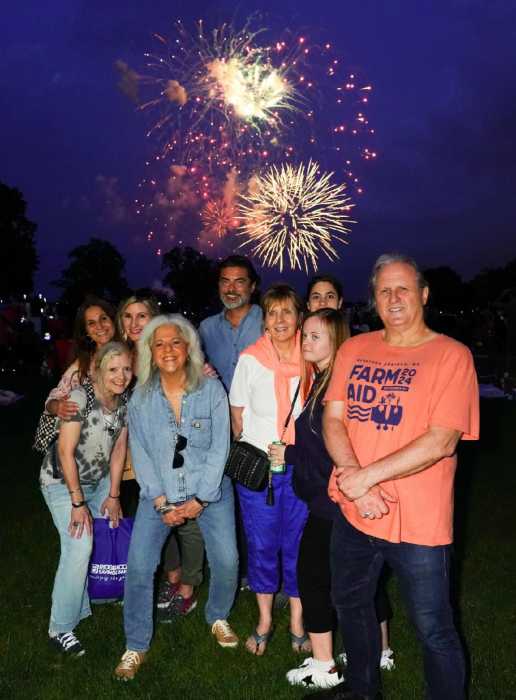By Ernest Barteldes
A keen observer of the comings and goings of his neighborhood, 41-year-old Lower East Side artist and musician Michael Rimbaud has spent the past few years painting portraits of every local resident that catches his eye — “the butcher, the baker and even the undertaker,” says Rimbaud. In the past year alone, he’s painted 50 portraits of personal friends and people he’s approached on the street. Many are on view now through February at The Theater for The New City Gallery (155 1st Ave. at 9th street). We spoke to Rimbaud about his exhibit, “Lower East Side Portraits,” and what it takes to be a Renaissance man.
You’re a musician, painter and graphic designer. How do you see yourself as an artist in general?
I am an artist with many interests, primarily painting and rock music. Graphic design helps pay the rent and I teach computer graphics, too. Leonardo DaVinci was the real Renaissance man. He wasn’t only a great painter and sculptor, he invented flying machines and submarines, weapons of small destruction and he also dissected humans.
What is your background as a painter? Did you study painting, or did it come from inspiration?
I was always the “class artist” in school. Teachers and other kids always were commenting on my pictures. I made my first underground comic book when I was eleven. It was called “Gross.” I don’t know if it’s worth much, but I was a huge fan of (cartoonist) R. Crumb and still am today. In high school I did caricatures of my teachers. One time in math class the teacher was visibly upset, thinking I was making fun of her. I had to explain that caricature is an art form, exaggerating distinctive features. I think she felt better after that and I always did well in math. I majored in painting in college and I earned a BFA. American artists like Edward Hopper, Alice Neal and Winslow Homer made a big impression on me, too. The Ash Can Artists of New York from the early 20th century [also] blow me away. They did many beautiful street scenes, kids swimming in the Hudson river, early subways, etc. I would like to consider myself in the same tradition.
Your father, Robert Grossman, is a cartoonist. How has he influenced you?
I began drawing very early on as a child. I remember being really impressed with how well my father could draw and I wanted to do the same. My dad often took me to art openings and museums here in New York. We lived in Soho. My father was a pioneer, loft-living artist in the 60s, back when rent was something like $50!
Your show at TNC — how would you describe it?
With Lower East Side Portraits I want to show the variety of people that live in this culturally rich neighborhood. I’ve lived here almost ten years and I’ve been inspired by the diversity here. I wanted to draw the butcher, the baker and even the undertaker. I’ve painted bartenders before they got fired and rockers who never get tired. I love the human face, old or young, everyone is different.
I [also] want to capture this period in New York like a 21st century Pieter Bruegel, George Grosz or Toulouse-Lautrec. Many of the paintings are in gouache, but I’m also doing some street scenes and cityscapes in oil. I approach people on the street and I ask if they mind if I sketch them. Often they say yes, sometimes no. Everyone painted is a real person; some I’ve known for years.
How do you choose people to paint? What catches your eye?
I want to capture all walks of life. Different cultures, ages and jobs. For example I was doing my laundry the other day and the woman who works there was folding some clothes by a dryer. Something in my mind then clicked like a camera and I say to myself, “that could be a great painting.” I had thirty five minutes before I had to take my wash out so I went home and came back with my paper and pencils.
Do you get to know all your subjects?
Every one is different and everyone has a story. Sometimes I’ll sketch a scene. I once sketched a older gentleman sitting at a bar and showed him the drawing after. He was mad, he said I should have asked if I could draw him, but he would have declined if I did. When I asked him for his name, he said, “How do I know you’re not an FBI agent?” Eventually he changed his mind. He told me his name was Henry. You’ll notice that many of the people I painted are smiling. I try to make everyone comfortable and have a nice conversation. I’m not after a photographic likeness either. I want to capture the person and make a good painting.
Who’s your favorite subject or your most unusual one?
My favorite subject is whoever is posing for me at the time. There are no unusual subjects.
What comes next for you?
I’m going to keep on doing my portraits and city scenes, getting deeper and deeper. I hope to find a publisher who will put out a book of my Brazilian work too. I’d like to do a mural somewhere like Diego Rivera did. My band, “The Subway Sun,” plays about once a month locally. The next show is at the Mercury Lounge, February 5th at 9:30.
How do you manage to fit all these things in?
A typical week has me juggling work, my art and music and raising my two wonderful children, I’m also a single parent. New Yorkers need to learn how to juggle. It’s not enough to have the balls.
Michael Rimbaud
“There’s no shortage of characters in New York,” says portraitist Michael Rimbaud. “In fact, there’s a surplus”— including Phyllis Sanfiorenzo, above, an actress Rimbaud met on Rivington Street.




































